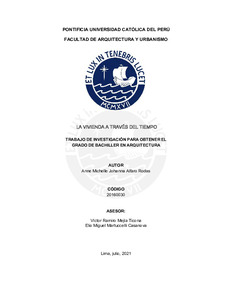La vivienda a través del tiempo. Análisis de las transformaciones realizadas en el concurso de vivienda experimental PREVI desde su creación hasta la actualidad en el ámbito formal, espacial y constructivo
Abstract
El Proyecto Experimental de Vivienda (PREVI) realizado entre 1969 y 1973 fue una de las
soluciones a los problemas de vivienda social existentes en la época y planteó interesantes
premisas que conllevaron a que se considere de gran importancia tanto su creación, como
su transformación a lo largo de los años. En la presente investigación se abordará ambas
etapas a través de 3 casos de estudio tomados de distintos proyectos peruanos. El primero
es la P6 diseñada por el Arq. Ernesto Paredes; el segundo, la P18, de los Arqs. Eduardo
Orrego y Ricardo Gonzales, y la P25 de los Arqs. Fernando Chaparro, Víctor Smirnoff, Víctor
Ramírez, Víctor Wiskowsky. Estas transformaciones se analizarán bajo 3 parámetros: el
aspecto constructivo, el cual abarca el sistema de creación y el usado para las ampliaciones;
el aspecto formal, se tiene en cuenta la apropiación de las personas en la ornamentación y
fachada, y; por último, el espacial, que implica las modificaciones realizadas en los distintos
espacios y el cambio de programa. La finalidad del análisis es tener un acercamiento del
grado de aceptación de las personas acerca del proyecto planteado y cómo sus necesidades
han cambiado al pasar los años. Todo esto con el objetivo de poder entablar bases para
futuras posibles iniciativas de vivienda social progresiva en el Perú. The Experimental Housing Project (PREVI), carried out between 1969 and 1973, was one
of the solutions to the social housing problems existing at the time and posed interesting
premises that led to its creation and its transformation over the years being considered of
great importance. This research will address both stages through three case studies taken
from different Peruvian projects. The first is P6 designed by Architect Ernesto Paredes; the
second, P18, by Archs. Eduardo Orrego and Ricardo Gonzales, and P25 by Archs. Fernando
Chaparro, Victor Smirnoff, Victor Ramirez, Victor Wiskowsky. These transformations will be
analyzed under 3 parameters: the constructive aspect, which includes the system of creation
and the one used for the extensions; the formal aspect, which takes into account the
appropriation of people in the ornamentation and facade, and finally, the spatial aspect,
which involves the modifications made in the different spaces and the change of program.
The purpose of the analysis is to have an approach of the degree of acceptance of people
about the proposed project and how their needs have changed over the years. All this with
the objective of being able to establish a basis for possible future progressive social housing
initiatives in Peru.
Temas
Arquitectura--Aspectos sociales--Perú--Lima
Planificación urbana--Perú--Lima
Viviendas--Proyectos
Planificación urbana--Perú--Lima
Viviendas--Proyectos
Para optar el título de
Bachiller en Arquitectura
Collections
The following license files are associated with this item:






